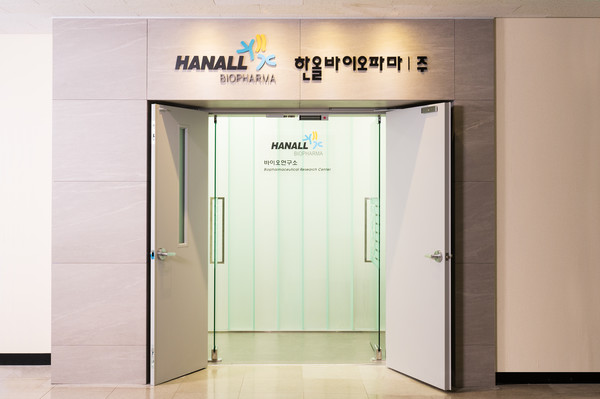It is difficult to treat rare and intractable diseases because causes and treatment methods remain unclear. However, new therapeutics are emerging one after another to fight these diseases.
So far, treatments for rare and intractable diseases have aimed to slow the disease progression or relieve symptoms. However, with medical advancement and policy support in recent years, drugmakers are actively engaging in developing new drugs.

Most of the leading multinational drugmakers and some Korean firms are aggressively investing in research and development to overcome rare and intractable diseases. HanAll Biopharma is one of them.
Tapping the market with unmet medical needs
Since 2007, HanAll Biopharma has taken a “patient-centered” strategy to develop innovative drugs and expand treatment options for patients with unmet medical needs.
Using this strategy, the company can identify patients’ inconvenience throughout the entire pipeline cycle, from market research to clinical trials, and reflect the results to improve their quality of life.
HanAll Biopharma’s pipeline HL036, jointly developed with Daewoong Pharmaceutical as a dry eye treatment, shows how the strategy works. Dry eye syndrome is caused by excessive or insufficient tear production. If it progresses to a severe condition, it can cause damage to vision or cornea. In addition, it causes feelings of burning or stinging that persist for a long time, reducing patients’ quality of life significantly.
The Kospi-listed company found a niche market where there was no treatment for dry eye despite the increasing number of patients and has conducted R&D for a new treatment mechanism since 2010.
According to the Health Insurance Review and Assessment Service statistics, Korea had 2.45 million patients with dry eye syndrome in 2020, and the number is on the rise. However, treatment options are limited, with only two dry eye treatments available on the market -- Allergan’s Restasis and Novartis’ Xiidra.
HanAll Biopharma expects that HL036 will not only cure dry eye syndrome but offer better convenience.
While conventional drugs only relieved symptoms and prevented the disease from progressing further, HanAll Biopharma’s drug aims to inhibit TNF alpha, a factor that causes inflammation on the ocular surface.
Anti-TNF antibodies are large particles that cannot penetrate the eye tissues. The company applied its protein engineering technology to create an optimized, molecular-sized biopharmaceutical to make it highly distributed in the eye tissues to overcome this shortcoming.
Developing drugs that reflect patients’ preference
HanAll Biopharma’s clinical studies and pipelines that reflect the needs of patients with rare diseases also draw attention. They not only relieve symptoms but identify what hurts the quality of life and reflect patients’ preference in drug forms, dosing methods, and dosages.
HL161 is an investigational therapy for autoimmune diseases such as myasthenia gravis that actively considers the needs of patients from the initial research stage to the clinical development.
Patients with myasthenia gravis greatly reduce the quality of life because antibodies, which are supposed to defend the body, attack the junctions between muscles and nerves, causing muscle weakness and disability.
According to a survey by Immunovant, a U.S. partner of HanAll, on 80 patients with myasthenia gravis, 94 percent of the respondents preferred continuous dosing to intermittent one. Due to fears of sudden seizures or convulsions, myasthenia gravis patients prefer to maintain improved symptoms through continuous drug administration. In addition, continuous dosing helps patients control the frequency of pain or symptoms caused by seizures and lead a normal life.
Considering these needs of the patients, HanAll designed the clinical study of HL161 that administers high-dose treatment for 12 weeks to improve symptoms rapidly and maintains the therapeutic effect through low-dose treatment.
HanAll considered patient convenience in the drug form of HL161. The company developed it as a subcutaneous injection administered at home instead of an intravenous injection that requires a medical professional’s administration. So, patients do not have to visit the hospital. Also, the injection was highly concentrated into 2cc, which can be administered quickly within 10 seconds, anytime, anywhere.
HanAll spent $37 million on R&D in 3 years
HanAll Biopharma continuously invests in R&D for biopharmaceutical drugs to provide new therapies for patients suffering from intractable diseases.
In the past three years, the company poured 47 billion won ($37.4 million) into R&D. Last year alone, the R&D investment was 15 billion won, which accounted for 15 percent of the annual sales last year. As a result, HanAll’s proportion of R&D out of the revenue ranks high among major Korean drug companies.
The company said that aggressive open collaboration with partner companies is HanAll’s other strategy to accelerate R&D. Joint development can reduce risks and speed up R&D for key pipelines, the company said.
HanAll’s Chinese partner Harbour BioMed and U.S. partner Immunovant are conducting trials of HL161 in China and the U.S., respectively, to treat myasthenia gravis. For HL036 trials, HanAll is working with Harbour BioMed in China and Daewoong in the U.S.
Last year, HanAll Biopharma invested in Alloplex and Nurron. Recently, it has been seeking to invest in Turn Biotechnologies, which studies cellular reprogramming to turn back the cells' biological clock.
The company is looking for opportunities to expand new pipelines continuously.
HanAll Biopharma Co-CEO Jeong Seung-won said the company had been dedicated to researching new biopharmaceuticals that can give hope to patients with rare and intractable diseases to improve human health.
“To diversify treatments in the global market, we will continue to work on new drugs, starting with the autoimmune disease treatment HL161 and dry eye syndrome treatment HL036."

